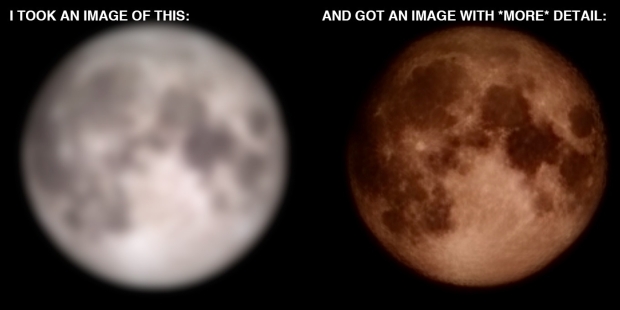Samsung phones such as the S20 Ultra come with the "space zoom" feature that allows the user to capture dazzling shots of the moon, but are they really real?
The space zoom feature debuted with the S20 Ultra back in 2020 and unlocked 100x zoom that allowed users to hone in on the moon and capture images never before achieved with a mobile device. The images were certainly impressive, and since then, there have been suspicions that they fake, similar to what Huawei has been accused of in the past. A Redditor has put together a thread that has gained a large amount of attention as they claim they have proven that Samsung is faking each space zoom moon shot, or at least isn't telling the whole truth about the capabilities of the feature.
The thread explains a user downloaded a high-resolution image of the moon and reduced it down to 170x170 pixels, then applied a gaussian blur. The blur removed any detail from the image and then the image was blown up on their monitor. The Redditor continues to explain they then moved to the other side of their room and snapped a photo of the blurry moon on the monitor using space zoom. The captured image showcased a large increase in the detail of the moon, leading the Redditor to conclude that Samsung is using an AI neural network that has been fed 100s, potentially thousands of images of the moon to add in detail where there is none.
Below is the testing process.

High-resolution image of the moon

Image reduced down to 170x170 and gaussian blur added

Image upscaled 4x to demonstrate the severity of the blur

Results of taking a photograph of the blurred image on the monitor

Image taken using space zoom

Side-by-side
The Redditor concluded that the images from Samsung that are used in its marketing are "fake", and that the company's marketing is "deceptive" as its adding in detail where there originally is none. Furthermore, the Redditor cites an explanation from Samsung where the company rejects the notion that it adds in image overlaying or texture effects when a photograph as it would cause similar objects to share the same texture patterns if an object were to be confused by the Scene Optimizer, the software within the device that identifies what the user is pointing the camera at.
However, the Redditor argues that while Samsung says it's not adding any textures into its images, it may be doing so as part of the process its AI runs when an image is taken. To illustrate their point further, the Redditor took the image of the moon and clipped the highlights to 216, meaning any region of the image with brightness above 216 is clipped to pure white creating a blob absent of any detail. The below video shows the resulting image containing new details.

A screenshot showcasing the image clipped at 216

The above video shows the resulting image containing new details
Samsung's explanation:
When taking a photo with the Galaxy S21 cameras and Scene Optimizer is activated, once AI recognizes the object/scene it will work through every step of processing. AI will first start by detecting the scene/image at the preview stage by testing it from an AI model trained on hundreds of thousands images. Once the camera detects and identifies the image as a certain scene, for example, the moon, then offers a detail enhancing function by reducing blurs and noises.
Additionally in low light/high zoom situations, our Super Resolution processing is happening (I.e., multi-frames/multi-exposures are captured > A reference frame is selected > Alignment and Registration of multi-frame/multi-exposures > Solution Output). The actual photo will typically be higher quality than the camera preview. This is due to the additional AI-based multi-image processing that occurs as the photo is captured.
For example, when taking photos of an object, 3 key elements are taken into place. Object detection (when scene optimizer is enabled), powerful AI processing and multiple frames enhancement. Each one of these features plays a critical role in order to deliver quality photos. When combined, these features generate the proper balance between a natural look and detail.
The process starts by identifying an object based on a realistic human eye view, then multi-frame fusion and upscaling adds on by generating a higher level of detail to the subject, finally leveraged by AI deep learning solution it uses contextual assumption to process and piece together all the information to delivering a high quality result.
No image overlaying or texture effects are applied when taking a photo, because that would cause similar objects to share the same texture patterns if an object detection were to be confused by the Scene Optimizer.
We know some users will want to capture images without AI involvement which is why disabling Scene Optimizer is a simple, convenient option. Simply press the icon to disable.




